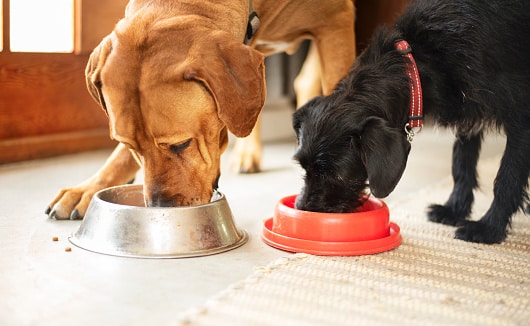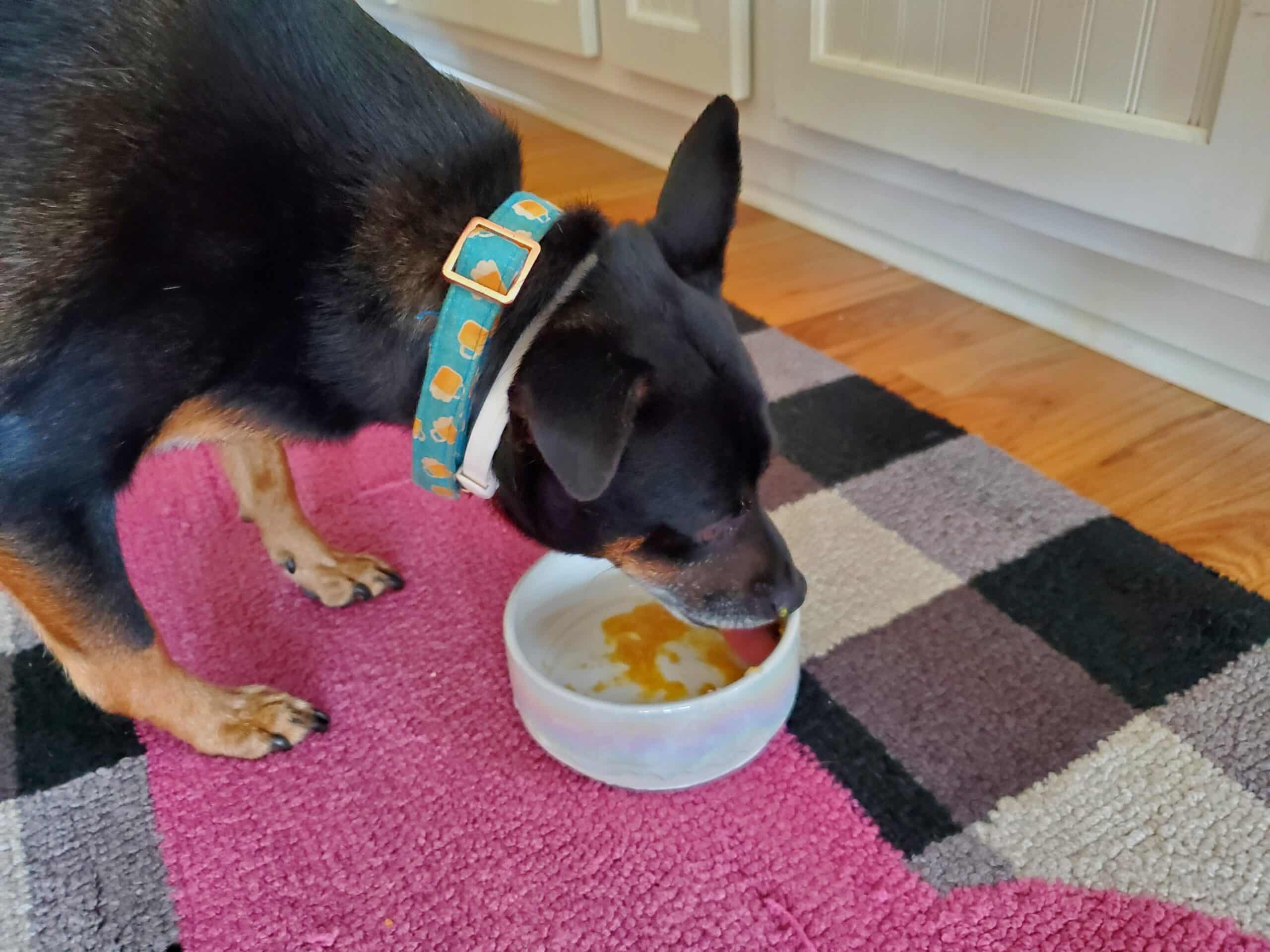Caring for a dog with food sensitivities brings up a lot of emotions — fear, frustration, worry and anger — even before you identify the specific sensitivity. Though understanding symptoms and managing your dog’s meals seems difficult up front, it ultimately makes for an easier and happier life for you and your dog.
Dog food sensitivity explained
Dogs with food sensitivities have negative reactions to specific food ingredients, and these reactions reside on a spectrum. Unlike food allergies, a food sensitivity does not involve the immune system, but rather the digestive system. Reactions to specific food ingredients range from mild to moderate to severe symptoms. That said, food allergies and sensitivities often share many of the same symptoms.
Symptoms of food sensitivities in dogs
Watch for the following symptoms after eating. Signs that your dog may be experiencing food sensitivities include:
- Vomiting
- Diarrhea
- Abdominal cramping
- Itchiness
- Hives
- Ear infections

These symptoms show in varying degrees and usually present themselves within six to 24 hours of ingredient consumption. Don’t overlook foods your dog has previously, safely consumed; sensitivities can develop at any time, which can be really frustrating and confusing!
The most common ingredients and foods that cause sensitivities dogs include:
- Dairy
- Beef
- Chicken
- Wheat
- Soy
Dog food sensitivity test
Unfortunately, veterinary professionals consider tests for identifying and diagnosing food sensitivities unreliable. These include saliva, serum (blood) and intradermal testing. However, additional tests can help eliminate other issues that share similar symptoms to food sensitivities.
These tests include:
- Skin tests. Ectoparasites and skin infections cause hives, itchiness and hair loss that often mirror symptoms of food sensitivities. Skin scrapings and tape preps are easy and affordable tests that rule out ectoparasites, such as mites. A skin culture is another noninvasive test that rules out fungal infections, such as ringworm.
- Fecal testing. Testing your dog’s stool sample rules out fecal parasites that cause vomiting, diarrhea, abdominal cramping, low energy or weight loss. Common parasites in dogs include coccidia, hookworm, whipworm and giardia.
- Environmental allergy testing. Many dogs with food sensitivities or allergies struggle with environmental allergies. Unlike food allergies, reliable testing for environmental allergies does Once diagnosed, environmental allergies can be well-managed using long-term treatments, such as immunotherapy. Managing your dog’s environmental allergies makes managing food sensitivities that much easier!
Food trial test for dogs with food sensitivity
The most formal “diagnostic” for food sensitivities and allergies is a food trial using an elimination diet. An elimination diet is a hypoallergenic diet that includes a novel protein source that your dog has had no prior exposure to. Examples of these proteins are catfish, kangaroo and alligator. Your dog remains on this elimination diet for approximately 8 to 12 weeks. Other foods, treats and supplements must be temporarily discontinued for accurate results. Choose from over-the-counter or prescription novel-protein diets, or prepare your own home-cooked elimination diet under the guidance of a veterinary nutritionist.
Commercial elimination diets, which are typically highly processed, might feel challenging for holistic pet parents. They also tend to be very expensive. While elimination diets can be used indefinitely, think of them as a temporary diagnostic tool, not a permanent solution.
Once your dog successfully stays on an elimination diet for the determined time frame, and if you see positive results, you then begin food challenges. A food challenge means you introduce one single ingredient into your dog’s diet at a time. From there, you can slowly begin reintroducing foods and work toward a more aligned and long-term diet for your pup. This process may take months.

Managing your dog’s food sensitivities
No one-size-fits-all approach exists. Focus on the following:
- Get to the root. As discussed, the single most important aspect to managing food sensitivities is to find the root problem (food ingredients) that your dog reacts to and completely eliminate these from his diet. This is easily the most time-intensive part of identifying and managing your pup’s food sensitivities.
- Build your team. Identifying and managing food sensitivities takes a lot of time, so team up with resources. Add a dermatologist, holistic veterinarian and traditional veterinarian to your team. Many holistic veterinarians offer phone consultations and are highly skilled in supporting dogs with food sensitivities. Search for a good holistic match by using the “Find a Member” tab on the American Holistic Veterinary Medical Association (AHVMA) site here. Onboarding all team members at once may feel financially burdensome. Start with your dog’s primary veterinarian and expand from there.
- Gut-healing protocol. Healing the gut and chronic inflammation may take time, and certain supplements help to sustain this process.
Your dog’s gut healing protocol may include:
- Probiotics. Add quality probiotics into your dog’s daily diet. Rotating probiotics helps introduce new strains into your dog’s gut flora, increasing diversity and benefits. Start with probiotics, or make your own using fermented blueberries!
- Bone broth. Filled with healing nutrients, bone broths can be very soothing to your dog’s GI tract. Pour over your dog’s food or freeze in ice trays as a cool treat. Avoid broths that have high fat content or are cooked with onions.
- Digestive enzymes. Digestive enzymes help expedite your dog’s digestion and improve vitamin and mineral absorption. Use a commercial digestive enzyme, such as or feed whole foods that are naturally high in digestive enzymes, such as pumpkin, fermented foods, quinoa or flax seed. Ensure that these foods are not sources that will trigger your dog’s food sensitivities.
- Keep a journal. You and your dog both will benefit from journaling about your dog’s food journey. Not only is journaling a place to process your own emotions around pet parenting, but it’s very helpful in establishing timelines around symptoms, diet adjustments, when you’ve opened new bags of food, different treats or any other changes that may be insightful for your veterinary team as they navigate managing your dog’s food sensitivities.
- Come up with a rescue plan. Stock up on your dog’s at-home medical pharmacy. Your veterinarian will likely support this, too. These include anti-diarrhea, anti-nausea and anti-itching medications. You’ll really thank yourself later if “things” hit the fan!
Remember that supplements can trigger reactions in dogs with food sensitivities. Always start with one supplement at a time and monitor responses, while also working closely with your pup’s veterinary team.
Identifying and managing your dog’s food sensitivities can feel absolutely daunting. It takes time, patience and persistence. Working with a well-resourced team and staying open to a holistic approach eases some of these struggles as you help your pup reach his optimal health. Some of the process may involve things that don’t feel aligned to you as a pet parent, such as feeding elimination diets and removing high-value treats. Remember that these steps are an often temporary yet important part of the process. You’ve got this!
Featured Image Credit: Sally Anscombe / Getty Images










